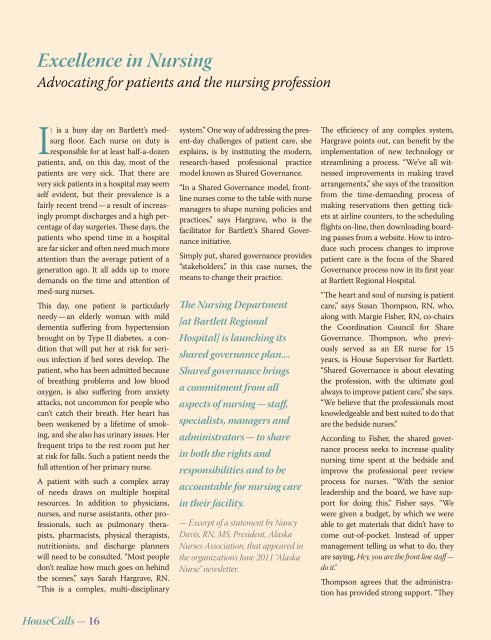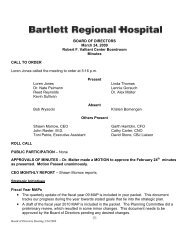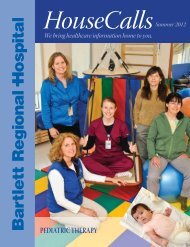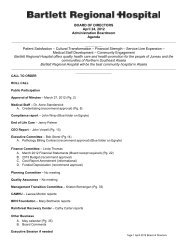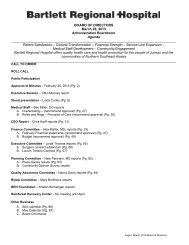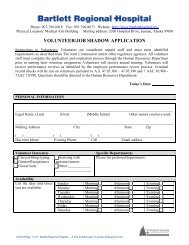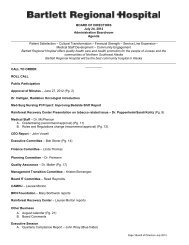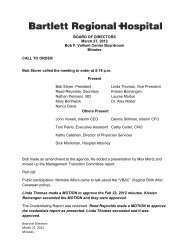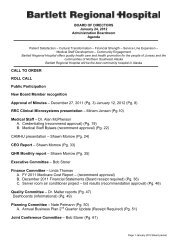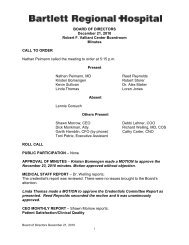Newsletter - Bartlett Regional Hospital
Newsletter - Bartlett Regional Hospital
Newsletter - Bartlett Regional Hospital
Create successful ePaper yourself
Turn your PDF publications into a flip-book with our unique Google optimized e-Paper software.
Excellence in Nursing<br />
Advocating for patients and the nursing profession<br />
It is a busy day on <strong>Bartlett</strong>’s medsurg<br />
floor. Each nurse on duty is<br />
responsible for at least half-a-dozen<br />
patients, and, on this day, most of the<br />
patients are very sick. That there are<br />
very sick patients in a hospital may seem<br />
self evident, but their prevalence is a<br />
fairly recent trend—a result of increasingly<br />
prompt discharges and a high percentage<br />
of day surgeries. These days, the<br />
patients who spend time in a hospital<br />
are far sicker and often need much more<br />
attention than the average patient of a<br />
generation ago. It all adds up to more<br />
demands on the time and attention of<br />
med-surg nurses.<br />
This day, one patient is particularly<br />
needy—an elderly woman with mild<br />
dementia suffering from hypertension<br />
brought on by Type II diabetes, a condition<br />
that will put her at risk for serious<br />
infection if bed sores develop. The<br />
patient, who has been admitted because<br />
of breathing problems and low blood<br />
oxygen, is also suffering from anxiety<br />
attacks, not uncommon for people who<br />
can’t catch their breath. Her heart has<br />
been weakened by a lifetime of smoking,<br />
and she also has urinary issues. Her<br />
frequent trips to the rest room put her<br />
at risk for falls. Such a patient needs the<br />
full attention of her primary nurse.<br />
A patient with such a complex array<br />
of needs draws on multiple hospital<br />
resources. In addition to physicians,<br />
nurses, and nurse assistants, other professionals,<br />
such as pulmonary therapists,<br />
pharmacists, physical therapists,<br />
nutritionists, and discharge planners<br />
will need to be consulted. “Most people<br />
don’t realize how much goes on behind<br />
the scenes,” says Sarah Hargrave, RN.<br />
“This is a complex, multi-disciplinary<br />
system.” One way of addressing the present-day<br />
challenges of patient care, she<br />
explains, is by instituting the modern,<br />
research-based professional practice<br />
model known as Shared Governance.<br />
“In a Shared Governance model, frontline<br />
nurses come to the table with nurse<br />
managers to shape nursing policies and<br />
practices,” says Hargrave, who is the<br />
facilitator for <strong>Bartlett</strong>’s Shared Governance<br />
initiative.<br />
Simply put, shared governance provides<br />
“stakeholders,” in this case nurses, the<br />
means to change their practice.<br />
The Nursing Department<br />
[at <strong>Bartlett</strong> <strong>Regional</strong><br />
<strong>Hospital</strong>] is launching its<br />
shared governance plan....<br />
Shared governance brings<br />
a commitment from all<br />
aspects of nursing —staff,<br />
specialists, managers and<br />
administrators — to share<br />
in both the rights and<br />
responsibilities and to be<br />
accountable for nursing care<br />
in their facility.<br />
— Excerpt of a statement by Nancy<br />
Davis, RN, MS, President, Alaska<br />
Nurses Association, that appeared in<br />
the organization’s June 2011 “Alaska<br />
Nurse” newsletter.<br />
The efficiency of any complex system,<br />
Hargrave points out, can benefit by the<br />
implementation of new technology or<br />
streamlining a process. “We’ve all witnessed<br />
improvements in making travel<br />
arrangements,” she says of the transition<br />
from the time-demanding process of<br />
making reservations then getting tickets<br />
at airline counters, to the scheduling<br />
flights on-line, then downloading boarding<br />
passes from a website. How to introduce<br />
such process changes to improve<br />
patient care is the focus of the Shared<br />
Governance process now in its first year<br />
at <strong>Bartlett</strong> <strong>Regional</strong> <strong>Hospital</strong>.<br />
“The heart and soul of nursing is patient<br />
care,” says Susan Thompson, RN, who,<br />
along with Margie Fisher, RN, co-chairs<br />
the Coordination Council for Share<br />
Governance. Thompson, who previously<br />
served as an ER nurse for 15<br />
years, is House Supervisor for <strong>Bartlett</strong>.<br />
“Shared Governance is about elevating<br />
the profession, with the ultimate goal<br />
always to improve patient care,” she says.<br />
“We believe that the professionals most<br />
knowledgeable and best suited to do that<br />
are the bedside nurses.”<br />
According to Fisher, the shared governance<br />
process seeks to increase quality<br />
nursing time spent at the bedside and<br />
improve the professional peer review<br />
process for nurses. “With the senior<br />
leadership and the board, we have support<br />
for doing this,” Fisher says. “We<br />
were given a budget, by which we were<br />
able to get materials that didn’t have to<br />
come out-of-pocket. Instead of upper<br />
management telling us what to do, they<br />
are saying, Hey, you are the front line staff —<br />
do it.”<br />
Thompson agrees that the administration<br />
has provided strong support. “They<br />
HouseCalls — 16


